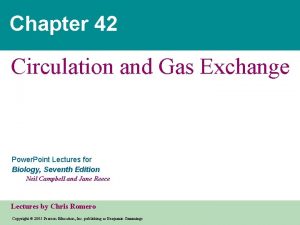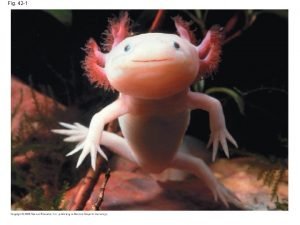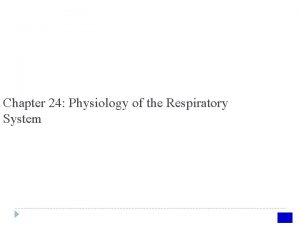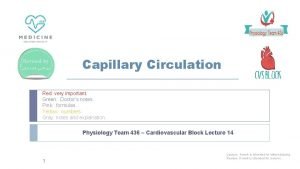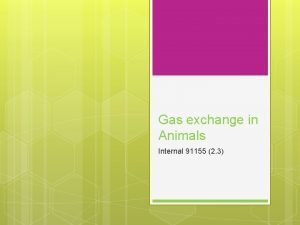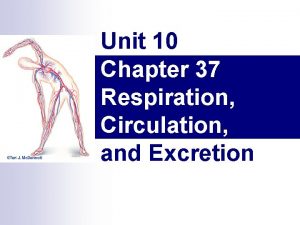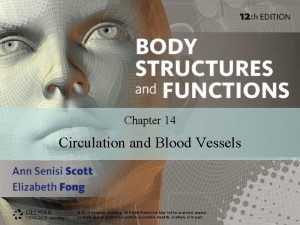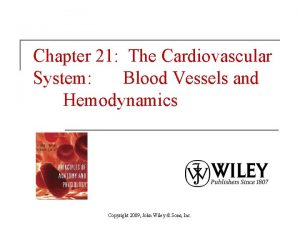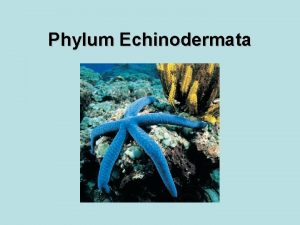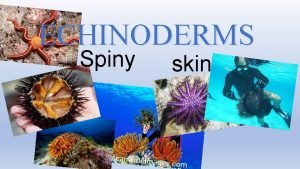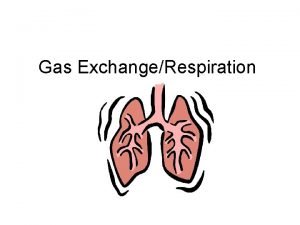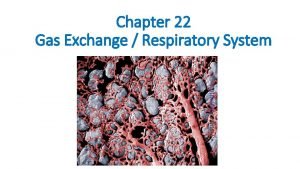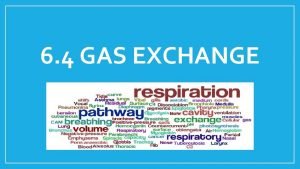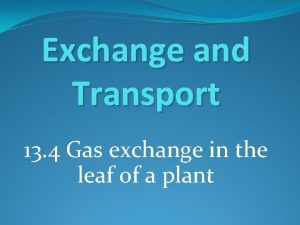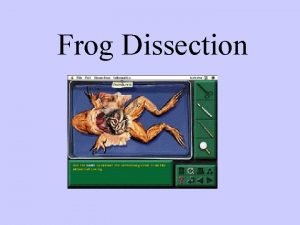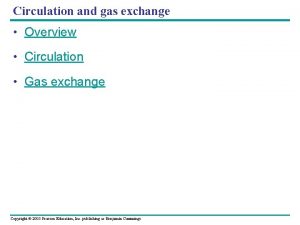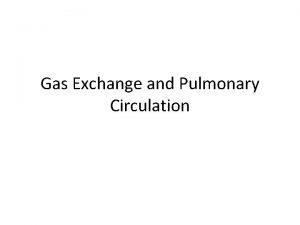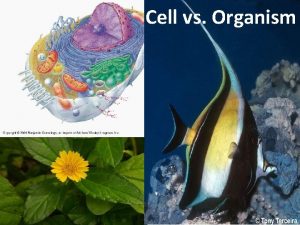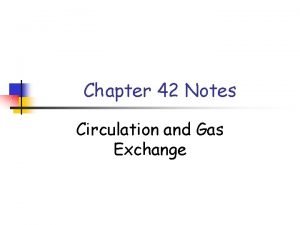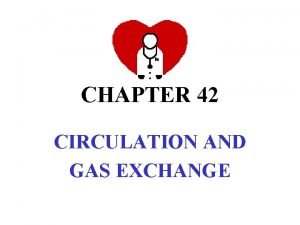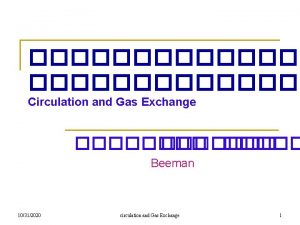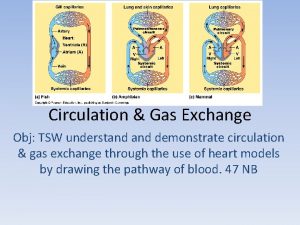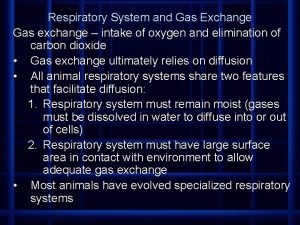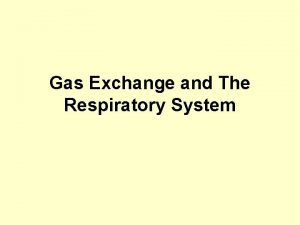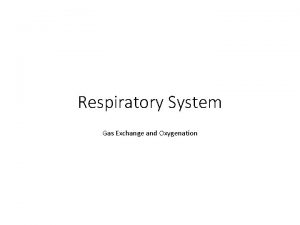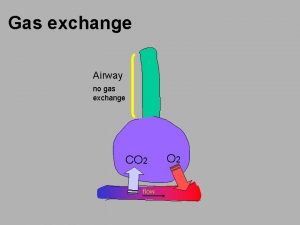CHAPTER 42 CIRCULATION AND GAS EXCHANGE Circulation in





























- Slides: 29

CHAPTER 42 CIRCULATION AND GAS EXCHANGE Circulation in Animals Part 1

Overview n n n Transport systems functionally connect the organs of exchange with the body cells: an overview Most invertebrates have a gastrovascular cavity or a circulatory system for internal transport Vertebrate phylogeny is reflected in adaptations of the cardiovascular system

Introduction n Every organism must exchange materials and energy with its environment, and this exchange ultimately occurs at the cellular level. n n n Cells live in aqueous environments. The resources that they need, such as nutrients and oxygen, move across the plasma membrane to the cytoplasm. Metabolic wastes, such as carbon dioxide, move out of the cell. Copyright © 2002 Pearson Education, Inc. , publishing as Benjamin Cummings

Introduction n Most animals have organ systems specialized for exchanging materials with the environment, and many have an internal transport system that conveys fluid (blood or interstitial fluid) throughout the body. n n n For aquatic organisms, structures like gills present an expansive surface area to the outside environment. Oxygen dissolved in the surrounding water diffuses across the thin epithelium covering the gills and into a network of tiny blood vessels (capillaries). At the same time, carbon dioxide diffuses out into the water. Copyright © 2002 Pearson Education, Inc. , publishing as Benjamin Cummings

Transport systems functionally connect the organs of exchange with the body cells: an overview n Diffusion alone is not adequate for transporting substances over long distances in animals - for example, for moving glucose from the digestive tract and oxygen from the lungs to the brain of mammal. Copyright © 2002 Pearson Education, Inc. , publishing as Benjamin Cummings

Transport by diffusion n Diffusion is insufficient over distances of more than a few millimeters, because the time it takes for a substance to diffuse to one place to another is proportional to the square of the distance. n n For example, if it takes 1 second for a given quantity of glucose to diffuse 100 microns, it will take 100 seconds for it to diffuse 1 mm and almost three hours to diffuse 1 cm. The circulatory system solves this problem by ensuring that no substance must diffuse very far to enter or leave a cell. Copyright © 2002 Pearson Education, Inc. , publishing as Benjamin Cummings

Bulk Transport n The bulk transport of fluids throughout the body connects the aqueous environment of the body cells to the organs that exchange gases, absorb nutrients, and dispose of wastes. n n n For example, in the mammalian lung, oxygen from inhaled air diffuses across a thin epithelium and into the blood, while carbon dioxide diffuses out. Bulk fluid movement in the circulatory system, powered by the heart, quickly carries the oxygen-rich blood to all parts of the body. As the blood streams through the tissues within microscopic vessels called capillaries, chemicals are transported between blood and the interstitial fluid that bathes the cells. Copyright © 2002 Pearson Education, Inc. , publishing as Benjamin Cummings

Most invertebrates have a gastrovascular cavity or a circulatory system for internal transport n n The body plan of a hydra and other cnidarians makes a circulatory system unnecessary. A body wall only two cells thick encloses a central gastrovascular cavity that serves for both digestion and for diffusion of substances throughout the body. n n The fluid inside the cavity is continuous with the water outside through a single opening, the mouth. Thus, both the inner and outer tissue layers are bathed in fluid. Copyright © 2002 Pearson Education, Inc. , publishing as Benjamin Cummings

Gastrovascular Cavities n In cnidarians like Aurelia, the mouth leads to an elaborate gastrovascular cavity that has branches radiating to and from the circular canal. n The products of digestion in the gastrovascular cavity are directly available to the cells of the inner layer, and it is only a short distance to diffuse to the cells of the outer layer. Fig. 42. 1 Copyright © 2002 Pearson Education, Inc. , publishing as Benjamin Cummings

Gastrovascular Cavities n Planarians and most other flatworms also have gastrovascular cavities that exchange materials with the environment through a single opening. n The flat shape of the body and the branching of the gastrovascular cavity throughout the animal ensure that are cells are bathed by a suitable medium and diffusion distances are short. Copyright © 2002 Pearson Education, Inc. , publishing as Benjamin Cummings

Gastrovascular Cavities n For animals with many cell layers, gastrovascular cavities are insufficient for internal distances because the diffusion transports are too great. Copyright © 2002 Pearson Education, Inc. , publishing as Benjamin Cummings

Circulatory Systems n In more complex animals, two types of circulatory systems that overcome the limitations of diffusion have evolved: open circulatory systems and closed circulatory systems. n Both have a circulatory fluid (blood), a set of tubes (blood vessels), and a muscular pump (the heart). n The heart powers circulation by using metabolic power to elevate the hydrostatic pressure of the blood (blood pressure), which then flows down a pressure gradient through its circuit back to the heart.

Open Circulatory Systems n n In insects, other arthropods, and most mollusks, blood bathes organs directly in an open circulatory system. There is no distinction between blood and interstitial fluid, collectively called hemolymph.

Open Circulatory Systems n One or more hearts pump the hemolymph into interconnected sinuses surrounding the organs, allowing exchange between hemolymph and body cells.

Open Circulatory Systems n In insects and other arthropods, the heart is an elongated dorsal tube. n n n When the heart contracts, it pumps hemolymph through vessels out into sinuses. When the heart relaxes, it draws hemolymph into the circulatory through pores called ostia. Body movements that squeeze the sinuses help circulate the hemolymph. Copyright © 2002 Pearson Education, Inc. , publishing as Benjamin Cummings

n Fig. 42. 2 b In a closed circulatory system, as found in earthworms, squid, octopuses, and vertebrates, blood is confined to vessels and is distinct from the interstitial fluid. n One or more hearts pump blood into large vessels that branch into smaller ones cursing through organs. n Materials are exchanged by diffusion between the blood and the interstitial fluid bathing the cells.

Vertebrate phylogeny is reflected in adaptations of the cardiovascular system n n The closed circulatory system of humans and other vertebrates is often called the cardiovascular system. The heart consists of one atrium or two atria, the chambers that receive blood returning to the heart, and one or two ventricles, the chambers that pump blood out of the heart. Copyright © 2002 Pearson Education, Inc. , publishing as Benjamin Cummings

Blood Vessels n Arteries, veins, and capillaries are three main kinds of blood vessels. n n n Arteries carry blood away from the heart to organs. Within organs, arteries branch into arterioles, small vessels that convey blood to capillaries. Capillaries with very thin, porous walls form networks, called capillary beds, that infiltrate each tissue. Chemicals, including dissolved gases, are exchanged across the thin walls of the capillaries between the blood and interstitial fluid. At their “downstream” end, capillaries converge into venules, and venules converge into veins, which return blood to the heart.

Blood Vessels n Arteries and veins are distinguished by the direction in which they carry blood, not by the characteristics of the blood they carry. n n All arteries carry blood from the heart toward capillaries. Veins return blood to the heart from capillaries. Copyright © 2002 Pearson Education, Inc. , publishing as Benjamin Cummings

Metabolic Rate n n Metabolic rate is an important factor in the evolution of cardiovascular systems. n In general, animals with high metabolic rates have more complex circulatory systems and more powerful hearts than animals with low metabolic rates. n Similarly, the complexity and number of blood vessels in a particular organ are correlated with that organ’s metabolic requirements. Perhaps the most fundamental differences in cardiovascular adaptations are associated with gill breathing in aquatic vertebrates compared with lung breathing in terrestrial vertebrates.

Fish Heart n n A fish heart has two main chambers, one atrium and one ventricle. Blood is pumped from the ventricle to the gills (the gill circulation) where it picks up oxygen and disposes of carbon dioxide across the capillary walls.

Fish Heart n The gill capillaries converge into a vessel that carries oxygenated blood to capillary beds at the other organs (the systemic circulation) and back to the heart.

Fish Heart n In fish, blood must pass through two capillary beds, the gill capillaries and systemic capillaries. n n n When blood flows through a capillary bed, blood pressure - the motive force for circulation - drops substantially. Therefore, oxygen-rich blood leaving the gills flows to the systemic circulation quite slowly (although the process is aided by body movements during swimming). This constrains the delivery of oxygen to body tissues, and hence the maximum aerobic metabolic rate of fishes.

Amphibian Hearts n Frogs and other amphibians have a three-chambered heart with two atria and one ventricle. n The ventricle pumps blood into a forked artery that splits the ventricle’s output into the pulmocutaneous and systemic circulations. Fig. 42. 3 b Copyright © 2002 Pearson Education, Inc. , publishing as Benjamin Cummings

Amphibian Hearts n The pulmocutaneous circulation leads to capillaries in the gas-exchange organs (the lungs and skin of a frog), where the blood picks up O 2 and releases CO 2 before returning to the heart’s left atrium. n n Most of the returning blood is pumped into the systemic circulation, which supplies all body organs and then returns oxygen-poor blood to the right atrium via the veins. This scheme, called double circulation, provides a vigorous flow of blood to the brain, muscles, and other organs because the blood is pumped a second time after it loses pressure in the capillary beds of the lung or skin. Copyright © 2002 Pearson Education, Inc. , publishing as Benjamin Cummings

Amphibian Hearts n In the ventricle of the frog, some oxygen-rich blood from the lungs mixes with oxygen-poor blood that has returned from the rest of the body. n However, a ridge within the ventricle diverts most of the oxygen-rich blood from the left atrium into the systemic circuit and most of the oxygen-poor blood from the right atrium into the pulmocutaneous circuit. Copyright © 2002 Pearson Education, Inc. , publishing as Benjamin Cummings

Reptilian Hearts n Reptiles also have double circulation with pulmonary (lung) and systemic circuits. n n However, there is even less mixing of oxygen-rich and oxygen-poor blood than in amphibians. Although the reptilian heart is threechambered, the ventricle is partially divided. Copyright © 2002 Pearson Education, Inc. , publishing as Benjamin Cummings

Four-Chambered Hearts n n n Fig. 42. 3 c In crocodilians, birds, and mammals, the ventricle is completely divided into separate right and left chambers. The left side of the heart receives and pumps only oxygen-rich blood, while the right side handles only oxygenpoor blood. Double circulation restores pressure to the systemic circuit and prevents mixing of oxygenrich and oxygen-poor blood. Copyright © 2002 Pearson Education, Inc. , publishing as Benjamin Cummings

Four-Chambered Hearts n The evolution of a powerful four-chambered heart was an essential adaptation in support of the endothermic way of life characteristic of birds and mammals. Endotherms use about ten times as much energy as ectotherms of the same size. n Therefore, the endotherm circulatory system needs to deliver about ten times as much fuel and O 2 to their tissues and remove ten times as much wastes and CO 2. n Birds and mammals evolved from different reptilian ancestors, and their powerful four-chambered hearts evolved independently - an example of convergent evolution. Copyright © 2002 Pearson Education, Inc. , publishing as Benjamin Cummings n
 Chapter 42 circulation and gas exchange
Chapter 42 circulation and gas exchange Gas exchange key events in gas exchange
Gas exchange key events in gas exchange Single vs double circulatory system
Single vs double circulatory system Single circulation and double circulation
Single circulation and double circulation Thin
Thin Fig 42
Fig 42 Pulmonary gas exchange and transport diagram
Pulmonary gas exchange and transport diagram Gas exchange between tissues and capillaries
Gas exchange between tissues and capillaries Gas exchange in plants and animals venn diagram
Gas exchange in plants and animals venn diagram Determination of exchange rate
Determination of exchange rate Voluntary exchange activity the pearl exchange
Voluntary exchange activity the pearl exchange Chapter 37 respiration circulation and excretion
Chapter 37 respiration circulation and excretion Chapter 14 circulation and blood vessels
Chapter 14 circulation and blood vessels Chapter 21 hemodynamics
Chapter 21 hemodynamics Gas law
Gas law Difference between ideal gas and real gas
Difference between ideal gas and real gas Gas exchange oxygen transport
Gas exchange oxygen transport Phylum
Phylum Countercurrent exchange in fish
Countercurrent exchange in fish Has an endoskeleton and usually a spiny skin
Has an endoskeleton and usually a spiny skin Grasshopper respiratory system
Grasshopper respiratory system How are plants adapted for gas exchange
How are plants adapted for gas exchange Egrette ch 22
Egrette ch 22 Gallant
Gallant Gas exchange
Gas exchange Impaired gas exchange subjective data
Impaired gas exchange subjective data Sponge amoebocytes function
Sponge amoebocytes function Gas exchange
Gas exchange Path of air into the lungs
Path of air into the lungs Frog
Frog
